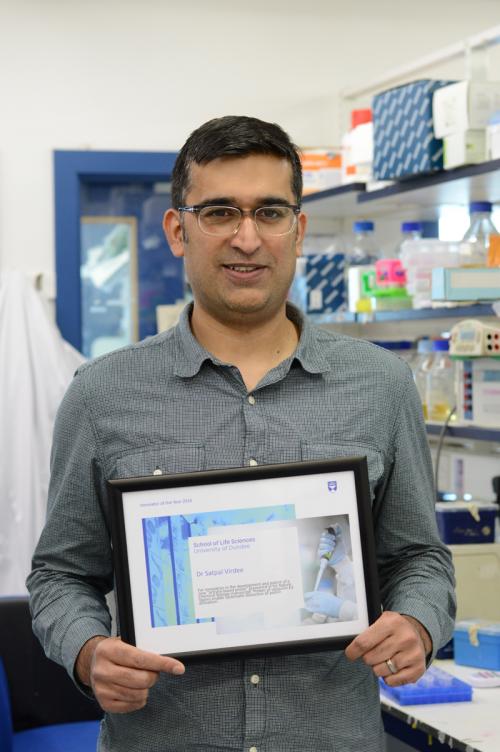
Congratulations to Satpal Virdee for being awarded the prestigious 2016 University of Dundee School of Life Sciences Innovator of the Year Award.
Satpal received his award for the development and patent of the new technology he developed to generate an “E3 ubiquitin ligase activity-based probe” that was recently published in the Nature Chemical Biology manuscript ‘Probes of ubiquitin E3 ligases enable systematic dissection of parkin activation’. The judging panel, consisting of Professor Irwin McLean, Professor Philip Cohen and Dr Fiona Mitchell from Research and Innovation Services, unanimously chose Satpal as the ‘technology is truly innovative in that it represents the creation of a new technology that hitherto did not exist, rather than application of existing technologies.’
The E3 activity probes were generated employing a new approach that Satpal describes as “a fusion of organic synthesis, genetic code expansion technology and protein labelling.” Satpal made the probe by “re-engineering” the ubiquitin charged E2 enzymes that are the co-factors that transfer ubiquitin to E3 ligases. The probe contains a chemical moiety that only reacts with active and not inactive E3 ligases. To demonstrate this system works, Satpal studied whether it could detect activation of endogenous Parkin E3 ligase after treatment of cells with the CCCP agent that induces mitochondrial depolarisation. He obtained striking data showing that the probe only reacted with endogenous Parkin in treated cells. Furthermore, Satpal obtained fibroblasts from Parkinson’s patient who lacked the upstream PINK1 kinase that triggers the activation of Parkin and their unaffected relatives. Using his system Satpal was remarkably able to demonstrate that his probe only reacted with Parkin in CCCP cells derived from unaffected relatives but not in the PINK1 deficient cells. Satpal’s PhD student Kuan-Chuan Pao undertook much of the work for this study.
This technology has significant potential to unbiasedly measure the activity of E3 ligases for the first time that are implicated with a diverse range of diseases. It will also enable to study of how these enzymes are regulated by growth factors, toll-like receptor and DNA damage agonists impact the activity in a wide range of cellular systems.

